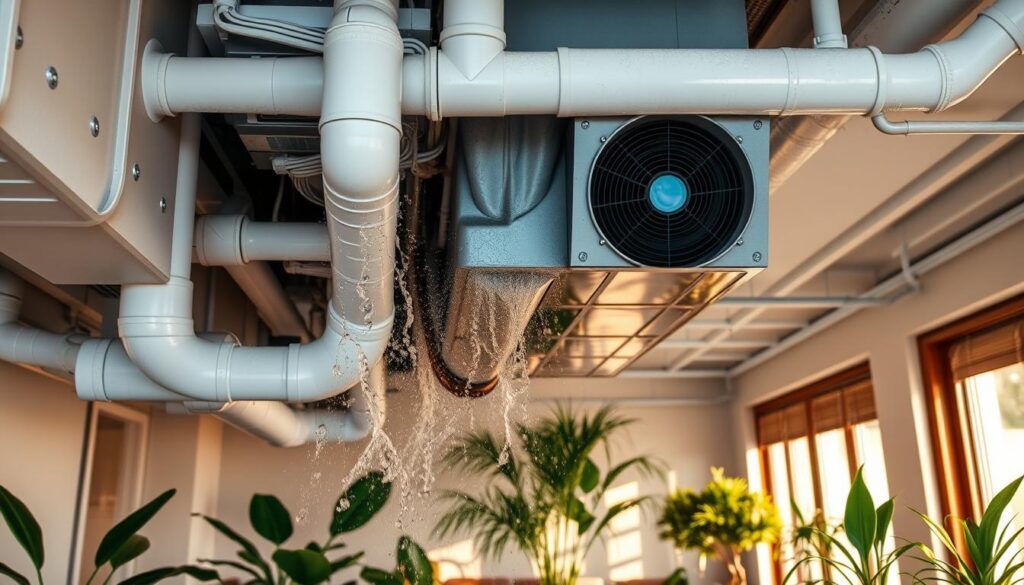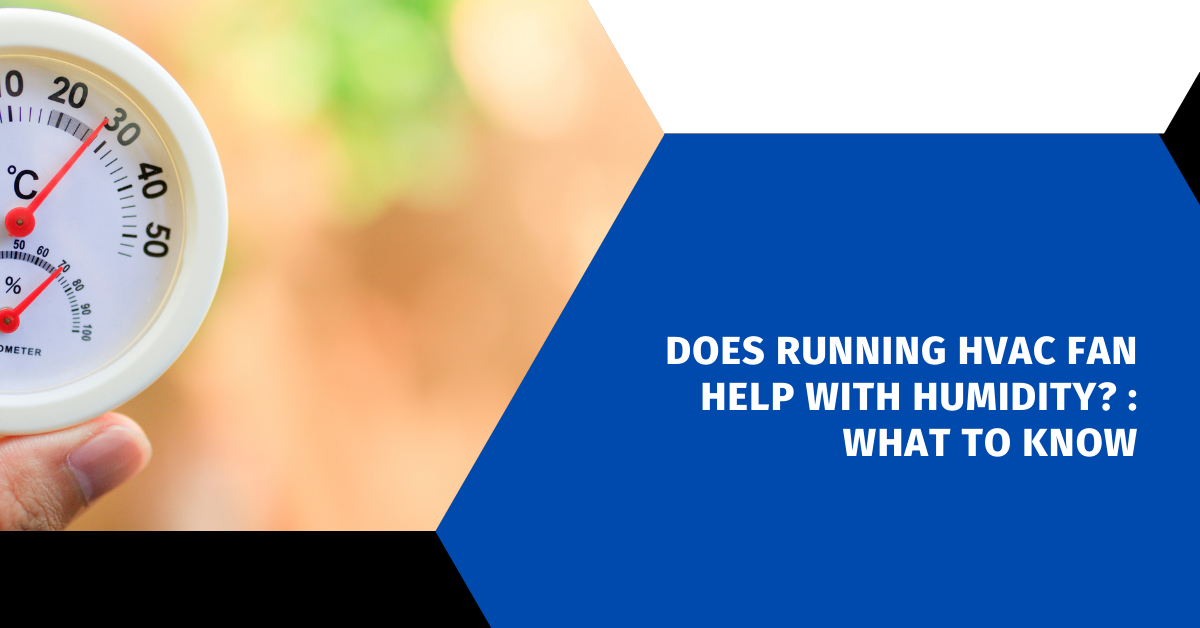Affiliate Disclosure
HVAC Guide Guys is a participant in the Amazon Services LLC Associates Program, an affiliate advertising program designed to provide a means for sites to earn advertising fees by advertising and linking to Amazon.
Managing indoor humidity can be confusing, especially when it comes to your HVAC fan. Does it help lower moisture in the air, or does it make it higher? Understanding how your HVAC fan settings affect humidity is crucial for a comfortable home.

The effect of your HVAC fan on humidity depends on its settings. Running it constantly in “ON” mode can make the air more humid. This is because it keeps circulating warm, moist air. However, the “AUTO” setting works well with your cooling system to control moisture.
Key Takeaways
- Running the HVAC fan continuously can impact dehumidification by circulating moisture back into the house.
- The “AUTO” fan setting can save energy and reduce costs by running the fan only when needed.
- Proper fan speed adjustment is crucial for optimizing HVAC system performance and maintaining proper airflow for cooling efficiency.
- Leaving the fan on 24/7 may lead to increased humidity levels by blowing warm air into the house during summer months.
- Setting the fan to “ON” provides cleaner air as it passes through the filtration or UV light system.
Table of Contents
Understanding HVAC Fan Settings and Their Impact on Home Humidity
The HVAC fan settings are key to managing indoor humidity. Most systems have “ON” and “AUTO” settings. Knowing how these settings work is vital for a comfortable home.
Difference Between ON and AUTO Settings
The “ON” setting keeps the fan running all the time. The “AUTO” setting only runs the fan when cooling or heating. This helps control moisture better.
How Fan Settings Affect Air Movement
Running the fan all the time can stop it from dehumidifying properly. The AC system is meant to cool and remove moisture. The “AUTO” setting helps remove moisture more effectively.
Basic HVAC System Components
A split-system air conditioner has two fans. One is for the outdoor unit, and the other is for the indoor unit. The indoor fan pushes cooled air through the ductwork. Knowing how these fans work is important for managing humidity.
| Fan Setting | Impact on Humidity | Energy Consumption |
|---|---|---|
| “ON” | Can increase indoor humidity levels by continuously blowing moisture back into the home | Uses more energy and costs more to operate |
| “AUTO” | Allows the AC system to effectively remove excess humidity from the air and expel it outside | Utilizes energy more efficiently during cooling/heating cycles |
Understanding HVAC fan settings helps you manage humidity and air movement. This ensures a comfortable and healthy home environment.
The Science Behind HVAC Fan Operation and Moisture Control
Your home’s HVAC system is key to keeping humidity levels right. It’s all about how the system’s parts work together. This affects moisture control.
Central air conditioners take out a lot of heat and some moisture from the air. The fan’s setting is important here. If it’s on “ON,” it runs all the time, even when it’s not cooling. This can make the system less effective at removing moisture.
But, if the fan is set to “AUTO,” it only runs when it’s cooling. This helps pull moist air over cold coils. The system then removes moisture more efficiently, and the water drains away.
| Fan Setting | Impact on Moisture Removal |
|---|---|
| ON | Reduces dehumidification efficiency by causing re-evaporation of moisture from the coils |
| AUTO | Optimizes dehumidification by allowing the system to remove moisture from the air during cooling cycles |
For the best humidity levels, experts say to use “AUTO” mode most of the time. This helps remove excess moisture while saving energy and keeping you comfortable.
Knowing how HVAC fans work is important for everyone. By picking the right settings and keeping the system in good shape, you can make your home comfortable and healthy. This keeps humidity levels just right.
Does Running HVAC Fan Help With Humidity?
The HVAC fan plays a big role in managing humidity in your home. But, running it all the time might not always help lower humidity.
Why Continuous Fan Operation May Increase Humidity
A fan that runs non-stop can move air around. But, it can also mess with the cooling cycle’s dehumidifying work. The cooling cycle is key for removing moisture from the air.
When the fan runs even when the compressor is off, air keeps moving without getting dry. This can make the air feel more humid and uncomfortable. In fact, running the AC fan 24/7 can actually increase humidity levels indoors.
The Role of Cooling Cycles in Dehumidification
The cooling cycles of your HVAC system are vital for removing moisture. During these cycles, the AC unit’s cold coils condense water vapor. This lets the excess humidity be drained away.
But, if the fan runs all the time, it stops the system from fully dehumidifying. To keep humidity levels right, it’s key to balance air movement and cooling/dehumidifying. The EPA recommends keeping indoor relative humidity (RH) below 60%, ideally between 30% and 50% to avoid mold and other moisture problems.
Understanding how the HVAC fan affects humidity helps homeowners keep their homes comfortable and healthy.
How Your AC System Removes Moisture From Indoor Air
Your AC system is key to keeping your indoor air quality high by removing extra moisture. This is vital for a comfy and healthy home. Here’s how it works:
Warm air from inside cools down as it hits the refrigerant coils in your AC. This cooling makes the water vapor in the air turn into droplets on the coils. Then, this moisture is drained away, lowering your home’s humidity.
The AUTO fan setting helps remove moisture between cooling cycles. This keeps your air dry and comfy. Keeping your AC well-maintained is important for good indoor air quality and moisture removal.
| AC System Component | Function in Moisture Removal |
|---|---|
| Refrigerant Coils | Cools the air, causing water vapor to condense |
| Drainage System | Removes the collected moisture from the coils |
| Fan | Circulates the air, allowing it to pass over the coils |
Knowing how your AC system handles moisture helps you manage your home’s humidity. This keeps your indoor space healthy and comfy.

The Relationship Between Fan Settings and Moisture Management
Getting the right balance between your HVAC fan settings and moisture management is key. It makes your home comfortable and saves energy. Knowing how condensation works and the role of the drainage system is crucial.
Understanding the Condensation Process
Warm indoor air meets the cold coils of your air conditioner. This makes the moisture in the air turn into water droplets. This process helps your HVAC system remove extra moisture from the air.
The drainage system then takes this water away. It helps keep the humidity in your home just right.
Drainage System Function
The drainage system is very important. It makes sure moisture is taken out of your home. If it doesn’t work right, you might get mold, bad smells, or even water damage.
Changing your HVAC fan settings can affect moisture management. The “AUTO” setting helps manage moisture and drainage well. But, running the fan all the time in “ON” mode can mess with this balance. It might make your home’s humidity go up.
Knowing about condensation and the drainage system helps you choose the best HVAC fan settings. This ensures your home stays comfortable and healthy.
Optimal Fan Settings for Humidity Control in Different Seasons
Keeping the right humidity in your home is key for comfort and air quality. The best fan settings for your HVAC system change with the season and where you live. Knowing how fan settings affect humidity lets you adjust your system to manage moisture all year.
In humid places like Florida, the AUTO fan setting works best for controlling humidity, especially in summer. The AUTO setting lets your HVAC system turn the fan on and off with the cooling cycles. This helps remove moisture from the air more efficiently, keeping humidity between 40% and 50% for summer comfort.
In drier seasons or areas, you can use the ON fan setting more often without worrying about too much humidity. For example, in winter, when the air is naturally drier, running the fan all the time helps move the air. This prevents humidity from getting too low, which can cause static, dry skin, and other problems.
| Season | Optimal Humidity Range | Recommended Fan Setting |
|---|---|---|
| Summer | 40% – 50% | AUTO |
| Winter | 25% – 40% | ON |
By changing your HVAC fan settings with the seasons and your local climate, you can control humidity better. This keeps your home comfortable and healthy all year.

Effects of Continuous Fan Operation on Indoor Air Quality
Managing your HVAC fan is key to a comfy and healthy home. Running the fan all the time has its perks, but it also affects air quality. Let’s look at how it impacts air filtration, dust control, and allergen reduction in your home.
Benefits for Air Filtration
Continuous fan operation means air always moves through the filter. This keeps more dust, pollen, and allergens out of the air. It makes your home air cleaner and healthier.
Impact on Dust and Allergen Control
Running the fan all the time helps control dust and allergens. It stops these particles from settling on surfaces. This is great for people with allergies or breathing issues.
Also, it helps catch dust and allergens while you clean. This makes your cleaning efforts more effective.
“Continuous fan operation can significantly improve indoor air quality by trapping more dust, allergens, and pollutants, making the air cleaner and healthier for residents.”
Knowing how continuous fan operation affects air quality helps you make better choices. You can balance the good of cleaner air with the energy use. This way, you can create a healthier home environment that suits your needs.
When to Use the “ON” Fan Setting Effectively
The “ON” fan setting on your HVAC system can be useful in some cases. But, it’s key to use it wisely to avoid raising humidity and energy use, especially in humid areas or seasons.
Running the fan all the time can be helpful during cleaning. It boosts air movement and helps filter out dust and allergens. This makes your indoor air cleaner and healthier.
Also, the “ON” setting is good for better air flow in big homes or places with still air. It ensures even temperatures and better air circulation.
| Benefit | Drawback |
|---|---|
| Improved air filtration and dust removal | Potential increase in humidity levels |
| Enhanced air circulation and temperature distribution | Higher energy consumption compared to “AUTO” setting |
But, using the “ON” setting too much can raise humidity and energy use, especially in warm, humid places. In these cases, the “AUTO” setting might be better for keeping your home comfy and saving energy.
“The most energy-efficient option for running the fan is setting it to AUTO, as the fan only runs when the system is actively heating or cooling air.”
Choosing to use the “ON” fan setting depends on your needs and your area’s weather. Knowing the pros and cons helps you pick the right balance between clean air and saving energy.
Common Mistakes in HVAC Fan Operation for Humidity Control
Getting the right balance between your HVAC fan settings and humidity control is tricky. Running the fan all the time, even when the cooling system is off, can be a big mistake. It can bring moisture back into your home, making it harder for your air conditioner to remove humidity.
Signs of Excessive Indoor Humidity
Too much humidity in your home can show up in different ways. For example:
- Condensation on windows
- Musty odors
- Visible mold growth
The Department of Health and Human Services says humidity over 70% is perfect for mold. This can harm your health.
Troubleshooting Humidity Issues
If you’re dealing with too much humidity, finding the cause is key. You might need to:
- Look for ductwork leaks that can make your HVAC system less efficient
- Check for refrigerant leaks that make your air conditioner blow warm air
- Make sure your HVAC system is the right size for your home’s needs
- Switch your thermostat fan settings to AUTO for better humidity control
By avoiding these mistakes and managing humidity well, you can keep your home comfortable and healthy.
Energy Consumption Considerations for Different Fan Settings
Choosing between “ON” and “AUTO” fan settings affects your HVAC system’s energy use and costs. It’s important to know how these settings work. This knowledge helps you find the best balance between comfort, air quality, and saving energy.
The ON setting keeps the fan running all the time. This uses more energy than the AUTO setting. The fan works hard, even when it’s not cooling. This can improve air flow and filter quality but also raises your electricity bills.
- Most experts say running the furnace fan all day is more energy-efficient. This can save you money.
- Keeping the fan on helps keep temperatures even in multi-story homes. This makes rooms more comfortable.
- The fan’s constant running helps control allergies. It improves air quality and spreads out allergens, which is good for people with allergies.
The AUTO setting is usually better for saving energy. The fan only works when the air conditioner is cooling. This means less energy use and lower costs for your HVAC system.
“Running a furnace fan all day is typically more cost-effective than solely relying on an air conditioning unit, with the former costing as much as a large cup of coffee per month compared to hundreds of dollars to run an AC unit.”
The fan setting’s efficiency also depends on your HVAC system’s age and condition. The home’s insulation and local climate also play a role. Sometimes, running the fan all the time is better. Other times, the AUTO setting is more suitable.
It’s key to balance energy use with keeping humidity in check, air quality, and comfort. Knowing how fan settings work helps you make choices that fit your home’s needs and energy goals.
Conclusion
Managing your HVAC fan is key to controlling humidity, air quality, and saving energy. The AUTO setting is usually better for these goals. But, the ON setting has its own benefits in some cases.
Knowing what your home needs is crucial. Adjusting your settings right can make your home more comfortable. This is important for HVAC management, humidity control strategies, and indoor comfort.
It’s important to find the right balance in fan operation and cooling cycles. Regular maintenance, like cleaning filters, helps too. This way, your HVAC system works better at controlling humidity.
By staying informed and making smart changes, you can improve your home’s comfort and energy use. HVAC fan management is vital for a healthy and comfy home. Understanding fan operation and humidity control helps you make your system work better.

